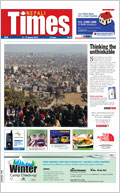 SHRINKHALA SHARMA THE GRASS IS GREENER IN THE MINEFIELD: These children were photographed recently collecting grass inside a mine or IED field surrounding the Nepal Army's Eastern Divisional Headquarters. The explosives have been laid in the area to the righ, marked with signs saying 'Bomb' in Nepali. |
Besides the continued suffering of the relatives of the dead and disappeared and the daily struggle of tens of thousands who were wounded, the other enduring legacy of the war are the explosives left behind. Explosive remnants of war continue to maim and kill long after the wars are over.
Two years after the end of hostilities, the army's landmines and the improvised explosive devices (IED) of the Maoists still lie scattered across the land. Despite the mine-clearing operations and an awareness campaign, people are still dying and being maimed by explosives. Many of them are children.
 |
 The three children were about to lift the concertina wire and go into the minefield to cut grass when they spotted the photographer. They seemed to know it was a restricted area.The soldiers on sentry duty in the bunkers above the minefield either did't see the children, or didn't try to stop them. |
Despite continued awareness-raising campaigns and mine risk education activities carried out throughout the country, the threat of explosives still loom large mainly for children and women.
"Nepal still ranks quite high amongst countries where children are falling prey to victim-activated explosions," says Danee, who says more needs to be done to spread awareness about explosives and clear them.
Shrinkhala Sharma in Sunsari


